#020: Aleurodiscus oakesii, Smooth Patch Disease

Aleurodiscus oakesii is a tiny mushroom whose effects are easier to see than the mushrooms themselves. The fungus causes Smooth Patch Disease, which — as the name implies — results in smooth patches of bark on hardwood trees.
Aleurodiscus oakesii is an unusual mushroom that grows on living trees but isn’t considered a parasite. The fungus decomposes the outer layer of hardwood tree bark. This doesn’t harm the bark but does cause smooth patches (thus the name “Smooth Patch Disease”). The mushrooms themselves appear occasionally inside these smooth patches. Each mushroom is a small tan roughly circular crust fungus, so some other common names for the fungus include: “Oak Parchment,” “Hop Hornbeam Disc,” and “Oake’s Crust.” These nondescript mushrooms are easier to identify by their ecology than morphology. Additionally, you can always see the smooth patches, but the mushrooms are more elusive. Despite regularly finding smooth patches, it took me four years to find the actual mushrooms.1–4
Ecology
Smooth Patch Disease affects a wide variety of hardwood trees, although it is most common on oak (especially white oaks), elm, and hop hornbeam. Although the fungus grows on living trees, mycologists do not consider it a parasite. It decays the outer layer of bark, which is composed of dead cells. A. oakesii ignores the inner layer of bark, which includes living cells that transport sugars and produce more bark cells. Since it decays only dead cells, the fungus is saprobic.1–4
The primary symptom of A. oakesii is an area of bark that is thinner, smoother, and lighter-colored than normal. If you live in North America east of the Rocky Mountains and find one of these patches on an oak, elm, or hop hornbeam, it’s probably due to A. oakesii. The fungus also occurs in Europe and Asia, although its hosts may differ in those areas. A. oakesii is most prominent in peoples’ yards, where the unusually smooth patches can be unsightly.1–4

A. oakesii produces small mushrooms with a smooth tan spore-producing layer. This groups it with the crust fungi. The mushrooms are circular and often fuse together with nearby fruitbodies.
Morphology
The fungus produces tiny mushrooms that are roughly circular and flush against the bark. Each mushroom is usually less than a centimeter across in any direction, although they can fuse together to form larger complexes. A. oakesii has a light brown surface that looks finely granular when you examine it with a loupe. Underneath, it is fuzzy and white. When the mushroom dries out, the edges often curl inward and make the underside visible, giving the fungus a kind of cup shape.1–4
Because of the mushroom’s small size and dull colors, you’re more likely to find A. oakesii by looking for the smooth patches in hardwood tree bark. The mushrooms can appear anywhere in the smooth area, but usually cluster around the edges.1–4
Under the microscope, A. oakesii has roughened or minutely spiny spores and features strange “acanthohyphidia” or “acanthophyses.” These structures are small hyphae adorned with prominent spines, which possibly deter insect predation.1,2,4
Similar Species
There are many different species of small crust fungi, but most of these are not well documented in field guides nor on websites. The most similar species is Aleurodiscus amorphus, which forms mushrooms that rarely fuse together. If you found the mushrooms on hornbeam, check A. oakesii against Cylindriobasidium laeve and Stereum striatum, which are similar and also grow on hornbeam.4

The underside of A. oakesii mushrooms is white and fuzzy. Each circular mushroom attaches to its substrate at a single central point. Where mushrooms have fused, there complex will have multiple points of attachment.
Etymology and Taxonomy
A. oakesii demonstrates that mycologists are pretty good at coming up with scientific names. “Aleuro” means flour, which refers to the powdery edges of the fruiting bodies. “Discus” refers to the roughly circular shape of the mushrooms. You’ll agree that Aleurodiscus is an apt name for this fungus. However, its species name, oakesii, is the truly clever part: it is actually a pun on the name of the man who collected the first recorded specimen of the fungus, William Oakes. How appropriate that Oakes’ powdery, circular fungus prefers growing on oak trees!2
The fungus also goes by the name Aleurodiscus wakefieldiae (named after mycologist Elsie Wakefield of the Royal Botanic Gardens).3 It isn’t clear which name is the correct one; Mycobank lists both names as valid.5,6 The Index Fungorum page for A. oakesii lists its current name as Acanthophysium oakesii, which makes things even more confusing.7 The Species Fungorum page for A. wakefieldiae lists A. oakesii as a synonym, but only in cases where the usage was based on Wakefield’s description.8 So, which name should you use? To answer that question, you would have to consult the original descriptions for each species and correlate those with modern DNA-based taxonomy. In other words, the answer is hidden somewhere in the pea soup of academia. For now, I’m sticking with A. oakesii – it seems to be more widely used and I like a good pun.
A. oakesii belongs to the order Russulales and family Stereaceae.5 This means its closest relatives are other crust fungi, such as those in the genus Stereum (such as the False Turkey Tail, Stereum ostrea, FFF#144). All these fungi belong to the same order as the genus Russula (see FFF#175), a prolific genus of gilled mushrooms.
| Kingdom | Fungi |
| Subkingdom | Dikarya |
| Division (Phylum) | Basidiomycota |
| Subdivision (Subphylum) | Agaricomycotina |
| Class | Agaricomycetes |
| Order | Russulales |
| Family | Stereaceae |
| Genus | Aleurodiscus |
| Species | Aleurodiscus oakesii (Berk. & M. A. Curtis) Pat.5 |
See Further:
http://www.mushroomexpert.com/aleurodiscus_oakesii.html
Citations
- Kuo, M. Aleurodiscus oakesii. MushroomExpert.Com (2006). Available at: http://www.mushroomexpert.com/aleurodiscus_oakesii.html. (Accessed: 1st September 2018)
- Volk, T. J. Aleurodiscus oakesii, the oak parchment, cause of ‘smooth patch disease’. Tom’s Fungi (2006). Available at: http://botit.botany.wisc.edu/toms_fungi/apr2006.html. (Accessed: 1st September 2018)
- Emberger, G. Aleurodiscus wakefieldiae. Fungi Growing on Wood (2008). Available at: https://www.messiah.edu/Oakes/fungi_on_wood/crust%20and%20parchment/species%20pages/Aleurodiscus%20wakefieldiae.htm. (Accessed: 1st September 2018)
- Labbé, R. Aleurodiscus oakesii / Corticie de Oakes. Les champignons du Québec (2014). Available at: https://www.mycoquebec.org. (Accessed: 1st September 2018)
- Aleurodiscus oakesii. Mycobank Available at: http://www.mycobank.org/name/Aleurodiscus%20oakesii&Lang=Eng. (Accessed: 1st September 2018)
- Aleurodiscus wakefieldiae. Mycobank Available at: http://www.mycobank.org/name/Aleurodiscus%20wakefieldiae. (Accessed: 1st September 2018)
- Aleurodiscus oakesii (Berk. & M.A. Curtis) Pat., Revue mycol., Toulouse 12(no. 47): 133 (1890). Index Fungorum Available at: http://www.indexfungorum.org/names/NamesRecord.asp?RecordID=205061. (Accessed: 1st September 2018)
- Aleurodiscus wakefieldiae Boidin & Beller, Bull. trimest. Soc. mycol. Fr. 82(4): 561 (1967). Species Fungorum Available at: http://www.speciesfungorum.org/GSD/GSDspecies.asp?RecordID=326004. (Accessed: 1st September 2018)

![#020: Aleurodiscus oakesii, Smooth Patch Disease of Oak [Archived]](https://www.fungusfactfriday.com/wp-content/themes/hueman/assets/front/img/thumb-medium-empty.png)





![#011: Characteristics of Kingdom Fungi [Archived]](https://www.fungusfactfriday.com/wp-content/themes/hueman/assets/front/img/thumb-small-empty.png)

No Responses
[…] so hard the bark stripped away. In actuality, these patches have Smooth Patch Disease, the work of Aleurodiscus oakesii, a saprophytic fungus that consumes the dead cells of the outer bark. Close inspection may reveal […]